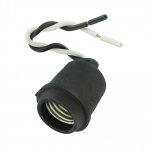BREEZY
Member
- Location
- rockfall, ct
- Occupation
- E-1 electrician
Hey guys,
Figured id give this a shot after I've spent a couple hours at a customers house trying to figure out an issue.
Customer called yesterday that their under cabinet lights randomly went out while they were on the couch watching tv. They noticed that the switch wasn't working so they went down to the panel and saw breaker tripped. Tried to turn it on and it just kept on tripping.
I arrived there today to spend a couple hours on it after working another job.
This breaker controls:
kitchen under cab lights
microwave
hallway bath lights
hallway bath gfi
hallway lights
hallway stair lights/ fan
attic lights
small gable vent fan
master bedroom fan/light
master bedroom bath lights
2 outside lights
Circuit is on a 15 amp breaker, now clearly someone added a ton of stuff to this circuit which would never fly and I wouldn't recommend.
First thing i did was switch the hot to another breaker to rule out bad breaker but it popped instantly. I tested my HOT wire to the neutral bar and got continuity and a resistance of 9 ohms.
started taking apart switches to test if there was continuity between hot and ground and there was. I told the customer after a couple hours after troubleshooting that I would have to return to do some more troubleshooting seeing as I'm going to have to figure out where the issue lies. The hardest part is having all these things on the same circuit there is a lot of spots there could be a fault.
I unplugged the microwave and anything that was plugged into an outlet. Still continuity between hot and ground/neutral
Just trying to see if anyone else has ever ran into this issue before of a randomly tripped breaker that wont turn back on and then had continuity between hot and ground.
Thank you!
Figured id give this a shot after I've spent a couple hours at a customers house trying to figure out an issue.
Customer called yesterday that their under cabinet lights randomly went out while they were on the couch watching tv. They noticed that the switch wasn't working so they went down to the panel and saw breaker tripped. Tried to turn it on and it just kept on tripping.
I arrived there today to spend a couple hours on it after working another job.
This breaker controls:
kitchen under cab lights
microwave
hallway bath lights
hallway bath gfi
hallway lights
hallway stair lights/ fan
attic lights
small gable vent fan
master bedroom fan/light
master bedroom bath lights
2 outside lights
Circuit is on a 15 amp breaker, now clearly someone added a ton of stuff to this circuit which would never fly and I wouldn't recommend.
First thing i did was switch the hot to another breaker to rule out bad breaker but it popped instantly. I tested my HOT wire to the neutral bar and got continuity and a resistance of 9 ohms.
started taking apart switches to test if there was continuity between hot and ground and there was. I told the customer after a couple hours after troubleshooting that I would have to return to do some more troubleshooting seeing as I'm going to have to figure out where the issue lies. The hardest part is having all these things on the same circuit there is a lot of spots there could be a fault.
I unplugged the microwave and anything that was plugged into an outlet. Still continuity between hot and ground/neutral
Just trying to see if anyone else has ever ran into this issue before of a randomly tripped breaker that wont turn back on and then had continuity between hot and ground.
Thank you!


